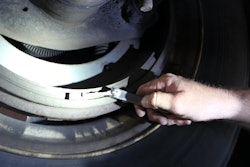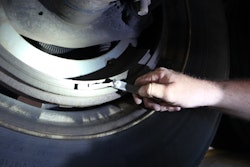Second only to fuel, tires are the major operational expense for fleets and owner-operators alike. Naturally, they want to get the most for their money both through maximum tire life and performance. To be in a position to help them reach these goals, knowing what tires to provide and how to care for them is paramount. Truck Parts & Service spoke with experts to determine some of the most frequently asked tire and wheel questions, and the appropriate responses, to help you give expert advice and aftermarket care.
Proper Spec’ing Is The First Step
The secret to long tire life starts with selecting the right tire for the vehicle and its intended application.
Q: Does vehicle application impact tire selection?
A: One of the biggest misconceptions about tires is that a tire is a tire is a tire. While at one time that was true, today tires are specifically made for the steer, drive and trailer axle positions. In addition, within each tire position, there are tires recommended for various applications.
According to Tim Walker, marketing communications manager, Goodyear Tire & Rubber Co., asking about the make and model of the vehicle, as well as the type of load carried and the type of service the vehicle will see, is critical to maximizing tire life.
“Thinking that a tire that works perfectly well for one job is going to work for another is one misconception. It is pretty specialized in today’s world,” he says.
Seek out tire product catalogs and literature to learn what’s available, and consult with your local representative if you encounter a gray or particularly difficult customer scenario.
Q: There has been a lot of talk about wide-base tires, are they really better than duals?
A: “There are certain segments of the industry that can benefit from wide-base tires,” Walker says. The biggest advantage of wide-base tires is the weight savings over standard duals. For customers in bulk-haul applications, this can be a significant advantage because every pound saved equates to more product in the tank.
“That means more revenue for the operator and you can’t argue with that,” says Walker.
Guy Walenga, director of engineering for commercial products and technologies, Bridgestone, says, “You can have as much as a 1000 lb. difference in vehicle weight by going from duals on steel wheels to wide-base tires on aluminum wheels. If you take that 1000 lbs. and turn it into a load, the tires start paying off. But if you are hauling boxes in a van trailer and you can not stuff another pound or cubic foot of material in, then wide-base tires are not going to give you the savings.”
To sum up, if your customer is weight sensitive and can use that extra weight saved for revenue purposes, wide-base tires are something your customer should look at. But an improvement in fuel economy is more of a gray area, according to Walenga.
He and Walker explain that most tire manufacturers offer standard dual tires in fuel efficient models so make sure your technicians are clear that their customer can use the lighter weight of the wide-base tires to generate additional revenue.
Keeping Tires Rolling
Once the proper tires are selected, the next step is to ensure they operate for their full expected lifespan. Paying attention to inflation pressure is perhaps the most significant, and simplest, way to ensure long tire life.
Q: How does underinflation affect tires?
A: Underinflation causes the tire to slowly begin to destroy itself until it finally comes apart, according to Walker. “The air in the tire helps keep it running at an acceptable operating temperature and when it is underinflated it creates more heat in the tire which eventually will destroy the tire,” he says.
While having tires underinflated by 5 percent may be insignificant from a durability standpoint, according to Walker, “when you start to get 10 percent or 20 percent below the recommended inflation pressure, you are beginning to build up quite a bit of extra heat in the tire and that is not good for its long-term life.”
Q: Does overinflation affect the tire’s performance?
A: An overinflated tire does not flex quite enough, according to Walenga, and creates a little bit stiffer ride. “The tire won’t take up the shock so the suspension will have to work at taking up the shocks,” he says.
Interestingly, according to Walenga, the majority of drive and trailer axles today are running overinflated. Fleets on average use about 100 psi on a standard low profile 22.5 tire for drive and trailer positions. They only need 75 psi to carry the maximum legal load. Most fleets focus their attention on the steer tire where proper inflation is critical, but the other positions should not be ignored.
Q: Why must inflation pressures in dualed tires be even?
A: According to Walenga, if you vary pressure between dual tires by as little as 5 or 6 psi, one tire will become larger than the other. “The two tires and wheels are bolted rigidly together and have to turn at the same rate to cover the same distance. But if one is tall and one is short, the shorter one is going to have to deform to catch up.”
As it deforms in and out of its footprint, irregular wear will begin to occur which affects fuel economy. “We are talking about a small loss of fuel economy but it happens on every revolution and it takes 500 revolutions for the truck to travel one mile. So this little bit of rolling resistance is additive and pretty soon you are losing a tenth of a mile a gallon.”
Q: Is nitrogen inflation better for tires than inflating them with air?
A: Both Walker and Walenga believe that using nitrogen to inflate tires works better with passenger car tires than with commercial vehicle tires. Since a commercial vehicle can be 1000 miles away from home, there is no guarantee that when the tires need additional inflation that nitrogen will be available, according to Walker. “As soon as you introduce something else into what is supposed to be 100 percent nitrogen, you have taken away any of the advantage that nitrogen may have. Therefore it becomes less effective in commercial applications than it is in consumer ones,” he explains.
Q: Are tire pressure monitoring/inflation systems a good investment?
A: Walker and Walenga are quick to say that anything that can be done to help keep tires properly inflated is a good thing. However, Walenga cautions to make sure that the technology pays for itself. Advise your customer to look at how expensive the system is, what the payback is and how much maintenance is needed for the system itself.
If by using a tire monitoring/inflation system your customer has one less flat tire during the course of the tire’s life, the system will pay for itself, according to Walenga.
Repairing Tire Problems
Despite proper spec’ing and care, tires still can encounter problems that will necessitate repairs.
Q: Why must tires be demounted prior to a repair?
A: A tire with a nail hole or other problems must be demounted so that it can be inspected from the inside out to determine the extent of the damage. While it may appear from the outside of the tire that a nail or screw went straight into the tire, it could have gone in crooked and be tearing the sidewall. Walker explains that if there is an injury to the tire, the technician should drill the hole out and remove any rust that may have formed. “A puncture allows moisture to get into the steel casing or belts and that can cause rust to form which can cause the tire to deteriorate. You can not see this damage without demounting the tire.”
Remember also that a nail hole puncture repair can only be made in the tread area of the tire. If the puncture is in the edge of the shoulder where the belts are located it is not repairable as a puncture repair and a section repair will be needed to salvage the tire.
Q: What is the proper type of bead lubricant to use when seating a tire?
A: Almost anything that is developed from a non-petroleum source can be used. In other words, according to Walenga, do not use diesel oil or machine oil because petroleum attacks rubber by drying it out and making the beads brittle. “You want the beads to slide in position on both sides of the tire so that the tire is concentrically mounted all the way around the wheel.”
You do not want it drenched in lubricant but you also do not want too little lubricant so that the bead hangs up. “The proper lubricant is made to be slick for a certain amount of time and then to gradually dry off and have a little tack to it so the tire does not slip around the wheel,” he explains.
He also advises against using dish soap or hand soap because although it is slippery initially it dries quickly and gets tacky fast. “It does not allow the beads to slide into position before it gets too tacky.”
Q: What is the biggest misconception about tire repair?
A: “People think that a nail hole is just a small thing so you can patch it on the wheel and let it go out,” Walenga says. “The professional and safe way to repair it is to demount the tire and wheel assembly, take the tire off the wheel and inspect the tire from the inside out.”
What About Wheels?
While fleets and technicians pay a great deal of attention to tires because they represent such a significant cost to the fleet, wheels often, mistakenly, are taken for granted. They do need some attention.
Q: What should a technician look for when inspecting a wheel?
A: The technician should look for hidden damage, cracks and wear. “They also need to check to see if it is dimensionally correct,” according to David Walters, manager, field service and warranty, Alcoa.
If the vehicle had a brake related incident, a tire fire or wheel bearing out, it could cause the wheel to get smaller on the open end. By rolling the wheel across the floor or using a carpenter’s square across the bead stop flanges, the technician can verify the wheel size and proper shape.
Q: When does a wheel need to be taken out of service?
A: The Commercial Vehicle Safety Alliance has guidelines for taking wheels out of service. A single crack that is more than three inches long, a crack that extends between any two holes (the hand hole, the stud hole or the center hold) or two or more cracks in the wheel indicate that the wheel should be taken out of service.
The primary reason wheels crack is from overloading which can be the result of a set of duals that have different tire pressures.
If the outside dual has 105 pounds of air and the inside dual has less than 80, the outer wheel will be carrying more of the load and that stress can lead to a crack.
“Other things that crack the wheel are abuse from tire mounting practices,” Walters says. “Instead of using the proper tools, the technician takes a sledgehammer to break the bead and this can damage the wheel.”
Q: Why is it important to match tires, wheels and rims?
A: One reason to make sure they match is safety. If you put the wrong size tire on the wheel it can come off. “Every tire and rim service manual has a matching chart so that the technician does not put a wider tire on smaller rim,” Walters says.








